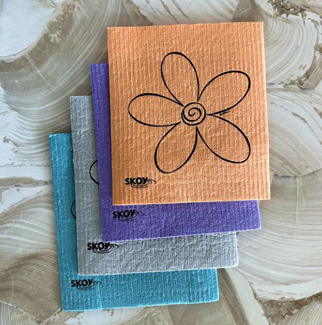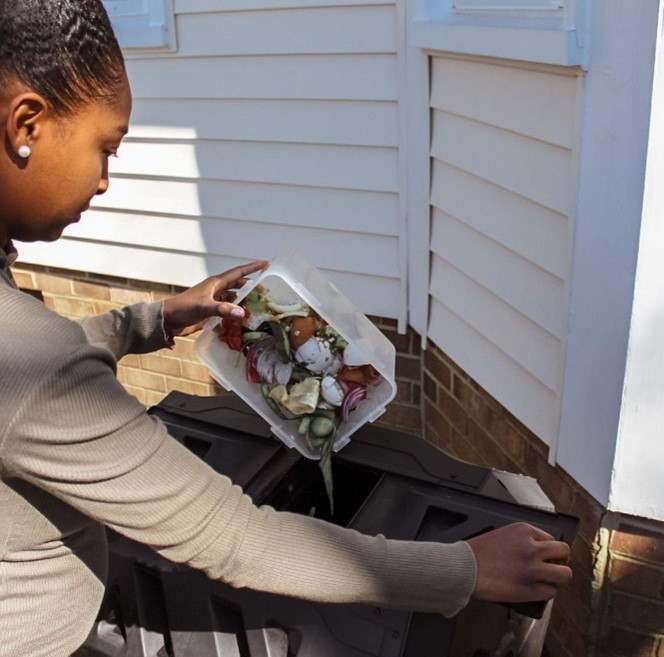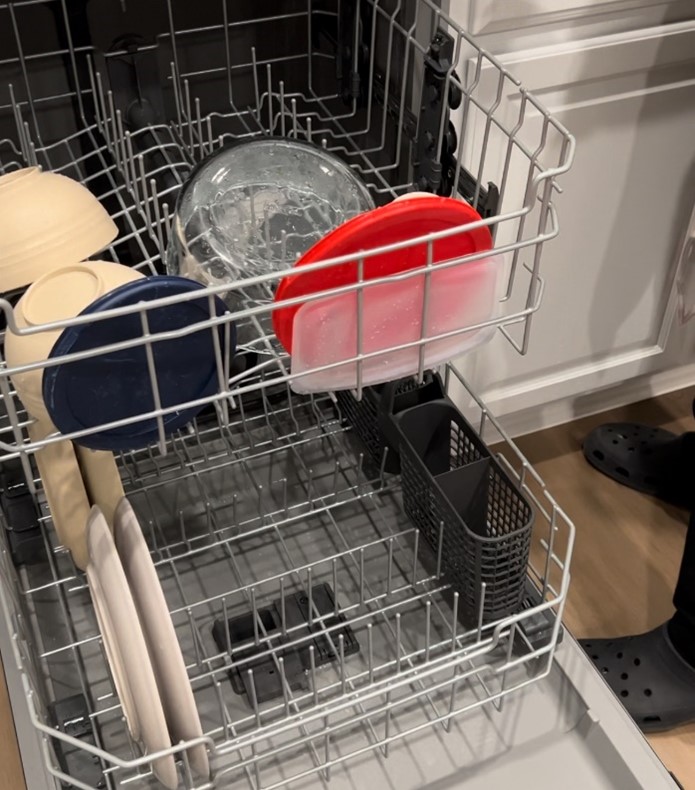Written by Lacie Wever, HRSD Community Education and Outreach Specialist Published on December 27, 2023
Whether it’s grabbing snacks for lunches and baseball practices or making dinners that my kids most likely won’t eat (if you know, you know!), I find myself in the kitchen a lot. With the extra time in the kitchen, I realized I was creating extra waste as well. I was washing dishes by hand multiple times a day – wasting water, constantly using paper towels for spills – wasting money and resources and throwing away the aforementioned dinners my children rarely ate – generating food waste.
A few years ago, I made a commitment to try to reduce my waste in the kitchen in order to not only save money, but also save natural resources and be more ecofriendly.
Here are some of the ways I reduce waste in my kitchen:
1. Skoy Cloths

Skoy cloths are a more environmentally friendly alternative to kitchen towels, paper towels, sponges, and dishcloths. They’re incredibly absorbent cloths that are durable enough to use as a dishrag yet gentle enough to use on countertop materials like granite and quartz. Skoy cloths are generally made from cotton and wood-based cellulose pulp. They’re biodegradable and compostable!
My favorite thing about Skoy cloths is that they’re reusable and excellent for cleaning up spills, making them a more sustainable paper towel replacement. In fact, Skoy cloths have an absorption factor of 15x its own weight (source). This can be compared to using 15 paper towels at once! Instead of tossing it after use, I can clean the cloth to reuse it over and over again.
To clean my Skoy cloth, I toss it in the dishwasher along with other dishes, or I toss it in the laundry with other towels.
These cloths are not only sustainable and made from natural material, but also a zero-waste kitchen product if composted after use!
2. Home Composter
Speaking of composting, my home composter is the next way I reduce waste in the kitchen. Although home composting may sound difficult and unattainable, let me be the first to tell you, I’ve perfected a composting routine that requires little effort and maximum benefit. Composting is a process that converts organic materials into a nutrient-rich soil amendment or mulch through natural decomposition (source). Composting is a way to reduce food waste by recycling food scraps and keeping those materials out of the landfill. 
When I first began composting at home, I used a large plastic bucket and drilled a few holes in the bottom for drainage. I used a large stick to stir the compost to help with the decomposition process. The bucket worked out very well as a starter compost because it was made from items I already had at home, and I didn’t need to buy anything new!
Currently, we use a compost tumbler. This makes composting at home even easier because I can simply spin the composter after adding new materials. This composter also has dual sides so while one pile is actively decomposing, I can add new organic material to the other side. So, one side is always “ready”, and the other side is always “working.”
To avoid rodents and prevent odor, I keep the items that I add to my compost very simple. Here’s what we compost in my home:
• All vegetable and fruit peels
• Leftover or spoiled fruits and vegetables
• Potato skins
• Coffee grounds and tea bags
• Eggshells
• Grass clippings
• Shredded paper
• Dry leaves
• Shredded paper bags and cardboard boxes
• And items that are clearly labeled home compostable (like used up skoy cloths!)
Any organic material placed in the compost bin instead of the trashcan helps to reduce methane, a greenhouse gas produced in landfills due to the lack of oxygen during the decomposition process.
Although our composter is kept outside, we have a small container we keep in the house where we add our daily compost scraps. To prevent smell from decomposition, we keep this container in the refrigerator until it is filled and ready to dump in the outdoor compost bin.
3. Dishwasher
There has been a long debate over which is more environmentally friendly – the dishwasher or handwashing. The truth? The dishwasher is almost always the more environmentally friendly option. Using the dishwasher not only helps to reduce water consumption, but it also helps to reduce the amount of detergent wasted. This is because dishwashers use a set amount of detergent, a controlled amount of water, and a consistent temperature.

Believe it or not, the temperature used to wash your dishes is significant when considering ecofriendly habits in the kitchen! According to the Guardian, the temperature of the water you are using is even more important than the amount of water and detergent, in terms of carbon footprint. That is, the hotter the water, the larger the carbon footprint.
For reference, below is a chart comparison of the carbon footprint of doing dishes in relation to temperature (source). CO2e stands for CO2 equivalent. It is the metric measure used to express the total greenhouse gases emitted as opposed to CO2 which only measure carbon emissions and does not account for other greenhouse gases (source).
• Almost zero CO2e: by hand in cold water (but the plates aren't clean)
• 540g CO2e: by hand, using water sparingly and not too hot
• 770g CO2e: in a dishwasher at 55°C or 131°F
• 990g CO2e: in a dishwasher at 65°C or 149°F
• 8,000g CO2e: by hand, with extravagant use of water
It is also important to note that the article found that washing dishes below optimal temperatures does not adequately remove bacteria. Therefore, by running my full dishwasher, I’m not only reducing my carbon footprint, but I’m also reducing the amount of water and detergent wasted.

Over time I have worked to create an eco-friendly kitchen routine that works for my family and is better for the environment. From my compostable skoy cloths to my dishwashing routine, these kitchen besties are essential to helping me reduce my waste at home! I’ve eliminated the use of paper towels, reduced the amount of water I use for cleaning, and reduced the amount of food I’m wasting daily!
For more ways to reduce waste in the kitchen, check out our blog about sustainable shopping food tips here!